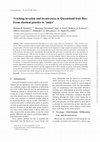Conference Presentations by William B Sherwin
Papers by William B Sherwin
Molecular Ecology, Feb 6, 2022
This is an open access article under the terms of the Creative Commons Attribution License, which... more This is an open access article under the terms of the Creative Commons Attribution License, which permits use, distribution and reproduction in any medium, provided the original work is properly cited.

Authorea (Authorea), Jun 2, 2023
The Australian range of little penguins, Eudyptula minor, extends around southern Australia, with... more The Australian range of little penguins, Eudyptula minor, extends around southern Australia, with range-edge sites near the large cities of Perth (west) and Sydney (east). Both range-edges are closer to the equator than the range-core, being likely to experience similar heating with climate change. As a result, movement to one range-edge is not an option for little penguins, unlike in many other species. Therefore, adaptation at the range edge might be very important for little penguins. Capacity for future adaptation depends upon the variability each site holds, and the amount of exchange between sites. In peripheral sites, incoming dispersal might either forestall demographic collapse and replenish genetic variation (good), or overcome local adaptation and increase disease transmission (bad). We aimed to establish the genetic variability in each site, and the exchange (dispersal) of individuals between sites. Genetic markers included biparentally-inherited microsatellites, and maternally-inherited mitochondrial DNA sequence. For microsatellites, no site appeared to have critically low variation, including the peripheral sites, however there was a significant but slight trend of increased variation from east to west. In contrast, mitochondrial DNA showed a pattern of significantly reduced variation at the two range-edges, possibly indicating differential dispersal patterns in males and females. There appear to be two main genetically distinct groups, in the west and the east, but analysis of lifetime dispersal patterns across the Australian range also suggests complex dispersal, sometimes with high dispersal or similarity between locations that are not adjacent. Our work suggests that despite some differentiation, little penguin sites are interdependent due to complex dispersal patterns, and all have valuable genetic variation. In particular, the peripheral sites are not depauperate of variation, and are moderately connected to the remainder of the distribution, so possibly may be able to adapt in response to climate warming.

Molecular Ecology, Feb 9, 2023
The genetic consequences of the subdivision of populations are regarded as significant to long‐te... more The genetic consequences of the subdivision of populations are regarded as significant to long‐term evolution, and research has shown that the scale and speed at which this is now occurring is critically reducing the adaptive potential of most species which inhabit human‐impacted landscapes. Here, we provide a rare and, to our knowledge, the first analysis of this process while it is happening and demonstrate a method of evaluating the effect of mitigation measures such as fauna crossings. We did this by using an extensive genetic data set collected from a koala population which was intensely monitored during the construction of linear transport infrastructure which resulted in the subdivision of their population. First, we found that both allelic richness and effective population size decreased through the process of population subdivision. Second, we predicted the extent to which genetic drift could impact genetic diversity over time and showed that after only 10 generations the resulting two subdivided populations could experience between 12% and 69% loss in genetic diversity. Lastly, using forward simulations we estimated that a minimum of eight koalas would need to disperse from each side of the subdivision per generation to maintain genetic connectivity close to zero but that 16 koalas would ensure that both genetic connectivity and diversity remained unchanged. These results have important consequences for the genetic management of species in human‐impacted landscapes by showing which genetic metrics are best to identify immediate loss in genetic diversity and how to evaluate the effectiveness of any mitigation measures.

Entropy, Aug 15, 2019
In ecology and evolution, entropic methods are now used widely and increasingly frequently. Their... more In ecology and evolution, entropic methods are now used widely and increasingly frequently. Their use can be traced back to Ramon Margalef's first attempt 70 years ago to use log-series to quantify ecological diversity, including searching for ecologically meaningful groupings within a large assemblage, which we now call the gamma level. The same year, Shannon and Weaver published a generally accessible form of Shannon's work on information theory, including the measure that we now call Shannon-Wiener entropy. Margalef seized on that measure and soon proposed that ecologists should use the Shannon-Weiner index to evaluate diversity, including assessing local (alpha) diversity and differentiation between localities (beta). He also discussed relating this measure to environmental variables and ecosystem processes such as succession. Over the subsequent decades, he enthusiastically expanded upon his initial suggestions. Finally, 2019 also would have been Margalef's 100th birthday.
Global Ecology and Biogeography, Jun 8, 2020
Aim: Tropical species are thought to be more susceptible to climate warming than are higher latit... more Aim: Tropical species are thought to be more susceptible to climate warming than are higher latitude species. This prediction is largely based on the assumption that tropical species can tolerate a narrower range of temperatures. While this prediction holds for some animal taxa, we do not yet know the latitudinal trends in temperature tolerance for plants. We aim to address this knowledge gap and establish if there is a global trend in plant warming risk. Location: Global.

Understanding how species will respond to climate change is critically important for managing our... more Understanding how species will respond to climate change is critically important for managing our ecosystems into the future. However, surprisingly little is known about the distribution of risk based on the actual thermal tolerances of species, especially plants. We used germination records from 776 species to provide a global map of plant warming risk – the difference between maximum germination temperature and the predicted 2070 temperature. We then tested a series of hypotheses about factors associated with high risk. Many of our predictions were overturned. For example, although a great deal of attention has been paid to the risks faced by tropical forests, we found that the biomes most at risk were tropical grasslands, savannas and shrublands. Similarly, while we expected Australian species to have a lower warming risk due to its already variable conditions, our data showed that Australia had the highest average warming risk. Conversely, European species faced the lowest risk, with no plants examined in this study predicted to exceed their upper limits by 2070. Plants from regions with higher seasonality and higher canopy cover had lower warming risk, but the absolute range of annual temperature had no effect on risk. Therefore, the underlying factors contributing to warming risk warrant further examination. Overall, our results highlight that the regions most at risk from warming are not necessarily those with the most warming, but regions where species are closest to their upper limits. More attention needs to be given to high risk tropical environments, especially non-forest tropical environments which face the highest risk. In summary, while much of the world’s biota faces substantial threats from climate change, researchers may be surprised about where the effects are most acute.
Authorea (Authorea), Jun 10, 2022
This a preprint and has not been peer reviewed. Data may be preliminary.

bioRxiv (Cold Spring Harbor Laboratory), Jul 4, 2022
Adaptive divergence is a fundamental process that shapes genetic diversity within and across spec... more Adaptive divergence is a fundamental process that shapes genetic diversity within and across species. Structural variants (SVs) are large-scale genetic differences (insertion, deletions, and rearrangements) within a species or population. SVs can cause important functional differences in the individual's phenotype. Characterising SVs across invasive species will help fill knowledge gaps regarding how patterns of genetic diversity and genetic architecture shape rapid adaptation in response to new selection regimes. In this project we seek to understand patterns in genetic diversity within the globally invasive European starling, Sturnus vulgaris. We use whole genome sequencing of eight native United Kingdom (UK), eight invasive North America (NA), and 33 invasive Australian (AU) starlings to examine patterns in genome-wide SNPs and SVs between populations and within Australia. The findings of our research demonstrate that even within recently diverged lineages or populations, there may be high amounts of structural variation. Further, patterns of genetic diversity estimated from SVs do not necessarily reflect relative patterns from SNP data, either when considering patterns of diversity along the length of the organism's chromosomes (owing to enrichment of SVs in sub telomeric repeat regions), or interpopulation diversity patterns (possibly a .
bioRxiv (Cold Spring Harbor Laboratory), Aug 23, 2021

Wildlife Research, 2023
Context. Rusa deer (Cervus timorensis), originally introduced in the 1860s, are still spreading i... more Context. Rusa deer (Cervus timorensis), originally introduced in the 1860s, are still spreading in eastern Australia. The expanding peri-urban rusa deer population in the Illawarra region of New South Wales, Australia is having undesirable impacts on human and ecological communities, but the spatial structure of this population has not been investigated. Genetic information on invasive species is potentially useful in identifying management units to mitigate undesirable impacts. Aims. The aim of this study was to investigate population structure, characterise dispersal, and determine if natural and human-made landscape features affected gene flow in rusa deer invading the Illawarra region of New South Wales. Methods. We used reduced representation sequencing (DArT-Seq) to analyse single nucleotide polymorphisms distributed throughout the genomic DNA of rusa deer culled during a management program. We used admixture and Principal Component Analyses to investigate population structure with respect to natural and human-made landscape features, and we investigated whether our genetic data supported the presence of sex-biased dispersal. Key results. Genetic diversity was highest in the north, near the original introduction site. A railway line demarcated restricted gene flow. Surprisingly, the Illawarra escarpment, a prominent landscape feature, did not restrict gene flow. There was no evidence of sex-biased dispersal and seven individuals were identified as genetic outliers. Conclusions. The genetic structure of the Illawarra rusa deer population is consistent with individuals spreading south from their introduction site in Royal National Park. The population is not panmictic, and a landscape feature associated with urbanisation was associated with increased spatial genetic structure. Outliers could indicate hybridisation or secondary incursion events. Implications. Rusa deer can be expected to continue invading southwards in the Illawarra region, but landscape features associated with urbanisation might reduce dispersal across the landscape. The genetic structuring of the population identified three potential management units on which to prioritise ground shooting operations.
Microsattelite data from 94 samples (<em>Stunus vulgaris</em>) from 3 populations and... more Microsattelite data from 94 samples (<em>Stunus vulgaris</em>) from 3 populations and including 29 loci. Used in the paper 'Simulated Disperser Analysis: determining the number of loci required to genetically identify dispersers'.

Current Zoology, Jun 1, 2015
Three Australian tephritid fruit flies (Bactrocera tryoni-Q-fly, Bactrocera neohumeralis-NEO, and... more Three Australian tephritid fruit flies (Bactrocera tryoni-Q-fly, Bactrocera neohumeralis-NEO, and Bactrocera jarvisi-JAR) are promising models for genetic studies of pest status and invasiveness. The long history of ecological and physiological studies of the three species has been augmented by the development of a range of genetic and genomic tools, including the capacity for forced multigeneration crosses between the three species followed by selection experiments, a draft genome for Q-fly, and tissue-and stage-specific transcriptomes. The Q-fly and NEO species pair is of particular interest. The distribution of NEO is contained entirely within the wider distribution of Q-fly and the two species are ecologically extremely similar, with no known differences in pheromones, temperature tolerance, or host-fruit utilisation. However there are three clear differences between them: humeral callus colour, complete pre-mating isolation based on mating time-of-day, and invasiveness. NEO is much less invasive, whereas in historical times Q-fly has invaded southeastern Australia and areas of Western Australia and the Northern Territory. In southeastern fruit-growing regions, microsatellites suggest that some of these outbreaks might derive from genetically differentiated populations overwintering in or near the invaded area. Q-fly and NEO show very limited genome differentiation, so comparative genomic analyses and QTL mapping should be able to identify the regions of the genome controlling mating time and invasiveness, to assess the genetic bases for the invasive strains of Q-fly, and to facilitate a variety of improvements to current sterile insect control strategies for that species [Current Zoology 61 (3): 477-487, 2015].
Biochemical Genetics, Feb 1, 1990
Etude chez Perameles gunnii de l'origine du polymorphisme de l'α1-antitrypsine et de la p... more Etude chez Perameles gunnii de l'origine du polymorphisme de l'α1-antitrypsine et de la phosphatase alcaline; utilisation de methodes biochimiques pour etudier la variation non-genetique possible de ces proteines

Wildlife Research, 2012
These could be new mutations that occurred during the exponential growth of the KI population. On... more These could be new mutations that occurred during the exponential growth of the KI population. On the assumption of uninterrupted exponential growth, the population growth rate on KI can be assessed, for it is known that the population went from N 0 = 18 at the time of the founding to N t = 27 000 in 2004, 80 years later. If we assume a koala generation time of 5 years (Martin and Handasyde 1999), the number of generations is 16. Because N t = N 0 e rt , then r = [ln (N t /N 0)]/t = 0.4570, equivalent to a per-generation rate of increase, l, of 1.5794. This value can be used to calculate the size of the population at each intervening generation, and thus the total number of individuals that have been available for mutation. This gives an estimate of 46 546 individuals in the pedigree leading to the present population. The mutation rate on KI can be derived from the following formula: mutation number divided by (microsatellite loci ¾ individuals) = 4/(15 ¾ 46 546) = 5.7 ¾ 10-6. This number is slightly lower than the range of the microsatellite mutation rates for eutherian mammals (between 10-3 and 10-5 ; Dallas 1992; Banchs et al. 1994; Ellegren 1995), possibly because of either the small number of koalas genotyped, or the assumptions inherent in the calculations. References

Conservation Genetics Resources, Dec 4, 2018
This study provides predictive equations for Shannon's information in a finite population, which ... more This study provides predictive equations for Shannon's information in a finite population, which are intuitive and simple enough to see wide scale use in molecular ecology and population genetics. A comprehensive profile of genetic diversity contains three complementary components: numbers of allelic types, Shannon's information and heterozygosity. Currently heterozygosity has greater resources than Shannon's information, such as more predictive models and integration into more mainstream genetics software. However, Shannon's information has several advantages over heterozygosity as a measure of genetic diversity, so it is important to develop Shannon's information as a new tool for molecular ecology. Past efforts at making forecasts for Shannon's information in specific molecular ecology scenarios mostly dealt with expectations for Shannon's information at genetic equilibrium, but dynamic forecasts are also vital. In particular, we must be able to predict loss of genetic diversity when dealing with finite populations, because they risk losing genetic variability, which can have an adverse effect on their survival. We present equations for predicting loss of genetic diversity measured by Shannon's information. We also provide statistical justification for these models by assessing their fit to data derived from simulations and managed, replicated laboratory populations. The predictive models will enhance the usefulness of Shannon's information as a measure of genetic diversity; they will also be useful in pest control and conservation.

PeerJ, Mar 29, 2018
Empirical genetic datasets used for estimating contemporary dispersal in wild populations and to ... more Empirical genetic datasets used for estimating contemporary dispersal in wild populations and to correctly identify dispersers are rarely tested to determine if they are capable of providing accurate results. Here we test whether a genetic dataset provides sufficient information to accurately identify first-generation dispersers. Using microsatellite data from three wild populations of common starlings (Sturnus vulgaris), we artificially simulated dispersal of a subset of individuals; we term this 'Simulated Disperser Analysis'. We then ran analyses for diminishing numbers of loci, to assess at which point simulated dispersers could no longer be correctly identified. Not surprisingly, the correct identification of dispersers varied significantly depending on the individual chosen to 'disperse', the number of loci used, whether loci had high or low Polymorphic Information Content and the location to which the dispersers were moved. A review of the literature revealed that studies that have implemented firstgeneration migrant detection to date have used on average 10 microsatellite loci. Our results suggest at least 27 loci are required to accurately identify dispersers in the study system evaluated here. We suggest that future studies use the approach we describe to determine the appropriate number of markers needed to accurately identify dispersers in their study system; the unique nature of natural systems means that the number of markers required for each study system will vary. Future studies can use Simulated Disperser Analysis on pilot data to test marker panels for robustness to contemporary dispersal identification, providing a powerful tool in the efficient and accurate design of studies using genetic data to estimate dispersal.

Mammal Review, Mar 1, 1991
It is now recognized that genetic data have an important role in the management of wild and capti... more It is now recognized that genetic data have an important role in the management of wild and captive populations. Valuable samples and data can often be obtained when animals are handled for other reasons, but unless the personnel involved are aware of the correct procedures, the sample taken will probably be useless. This article outlines appropriate procedures, and the data that can be obtained from them, so that when an opportunity arises, a quick decision can be made about feasibility of sampling and the usefulness of the data for management or research. This paper does not cover the veterinary aspects of obtaining the sample, nor its laboratory analysis, which are assumed to be well understood by the donor and recipient organizations, respectively. Every attempt has been made to develop techniques which are simple, and allow storage of the sample while arrangements are made with a suitable recipient laboratory.

Animal Genetics, Sep 1, 2014
Stock enhancement, restocking and sea ranching are being increasingly applied in both fisheries a... more Stock enhancement, restocking and sea ranching are being increasingly applied in both fisheries and conservation. The contribution of hatchery stock to fishery harvest and the maintenance of the genetic structure of stocked populations are both important considerations when releasing captive-bred organisms into natural systems. Use of wild-caught broodstock generally overcomes some of the genetic problems associated with domesticated hatchery populations, but there is still a need to ensure that a sufficient proportion of the natural population contribute to production of the stocked cohort to realise the genetic benefits of using wild-caught broodstock. Releases of Penaeus (Melicertus) plebejus are under investigation as a means of increasing prawn production in recruitment-limited areas. We used the highly variable mitochondrial control region (mtCR) to assign post-larvae to maternal lineages in the hatchery and also to investigate the reproductive performance of female broodstock in terms of contribution to the production of the cohorts of post-larvae in the hatchery. Our data showed that mtCR can be a useful tool for tracking lineages and provided genetic evidence that unequal contribution and underproducing females can occur even in wild-caught broodstock. This work therefore highlights the importance of monitoring the genetic composition of pre-release hatchery stocks.
Frontiers in Genetics, Mar 11, 2022











Uploads
Conference Presentations by William B Sherwin
Papers by William B Sherwin